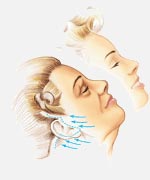| Rhytidectomy Surgery (Facelift; Minilift; Cheeklift; Necklift)
Turning back the clock is something many people would like to do. A facelift is a surgical procedure that can help remove wrinkles and tighten sagging skin. A face lift, or rhytidectomy, can help our clients to reverse the effects of age and exposure to the elements. Dr. Pryor uses the procedure to tighten facial muscles and to remove excess skin in the face and jowl area. Each face lift performed by Dr. Pryor is highly individualized. He will carefully assess every aspect of your face, including skin texture, bone structure, muscle tone, and the desired final outcome. During the facelift procedure, the incisions are usually hidden within the hairline in order to hide scars and maintain a natural appearance. A facelift can be performed as an outpatient procedure and the patient should be able to return to normal activities within a few weeks. An elastic dressing is applied overnight. This dressing is removed the following morning. Most patients experience some swelling and bruising though discomfort is usually mild. After a face lift, our patients typically return to work in two weeks. A facelift is often performed in conjunction with other surgical and non-surgical procedures such as blepharoplasty, neck lift, and brow lift to ensure a holistic approach to facial aesthetics. |
Successful facial plastic surgery is a result of good rapport between patient and surgeon. Trust, based on realistic expectations and exacting medical expertise, develops in the consulting stages before surgery is performed. Your surgeon can answer specific questions about your specific needs.
|
 |
||
Is A Facelift For You? Before deciding on a facelift, you should discuss with your facial plastic surgeon whether the overall effect will be more successful if additional changes are made in the chin and neck areas through other facial surgery. Many patients decide to have facial liposuction to remove excess fatty deposits in conjunction with a facelift. If several flaws need correction, more than one procedure may be necessary for the best overall result.> Making The Decision For A Facelift After the decision to proceed with a rhytidectomy is made jointly by you and your surgeon, the surgeon will describe the technique indicated, the type of anesthesia, the surgical facility, any additional surgery, the pros and cons to include possible complications, and costs of the procedure.
What To Expect After The Surgery In some cases, a drainage tube may have been inserted during surgery. This will be removed on the first or second day after surgery. All sutures and staples are usually removed within five to 10 days following surgery. Surgeons generally recommend that patients avoid vigorous activity. Patients should prearrange for post-surgery support from family and friends. Recovery usually takes two to three weeks, though many patients go back to work in two weeks. Scars are usually not noticeable after enough time has passed for them to mature. In any case, they are easily disguised in natural skin creases, by the hair, or, in persistent cases, by makeup until total healing has occurred. Bear in mind that the aging process continues after surgery and that some relaxation of tissues will occur over the first few weeks. Facial plastic surgery makes it possible to correct many facial flaws and signs of premature aging that can undermine self-confidence. By changing how you look, cosmetic surgery can help change how you feel about yourself. Insurance does not generally cover surgery that is done purely for cosmetic reasons. Surgery to correct or improve genetic deformity or traumatic injury may be reimbursable in whole or in part. It is the patient's responsibility to check with the insurance carrier for information on the degree of coverage. |
|||


